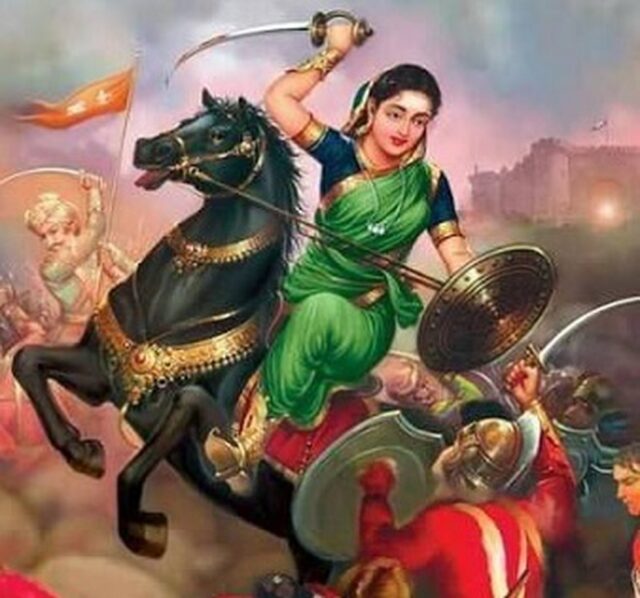
–Dr Nanditha Krishna
It is a little known fact that most of the revolts against British began in South India. Puli Thevar and Veerapandi Kattaboman, Palayakkarars (Poligars) of the mid- and late eighteenth centuries in Madras Presidency; the Marudu Pandyan brothers who revolted between 1799 and 1801; the Vellore Sepoy mutiny of 1806; and the revolt of Pazassi Raja of Kottayam in Kerala (1792 to 1805), are but a few examples of pre-1857 revolts. All the mutineers were ruthlessly killed – hanged, decapitated, or blown from canons – but they refused to apologise and get reinstated under British rule. There was great dissatisfaction in South India where the British were arbitrarily annexing lands and destroying flourishing local economies – textile, metallurgy and agriculture, among others – to be supplanted by revenue-generating transportation of local resources to the United Kingdom for boosting the British economy.
Rani Chennamma, the queen of Kitturu was one such warrior who led a war against British forces in early part of 19th Century when not many rulers were familiar with the evil designs of the British. She was the first Indian ruler to lead an armed rebellion against the British East India Company. She was outnumbered and arrested, but she is still remembered for leading the revolt against British rule in India.
Chennamma was born in Kakati, a small village in today’s Belagavi district of Karnataka. She became queen of Kitturu (now in Karnataka) when she married Raja Mallasarja of the Desai family. They had one son who died in 1824. After the death of her son, she adopted another child, Shivalingappa, and made him heir to the throne. However, the British East India Company did not accept this under the Doctrine of Lapse, a policy of annexation devised by the British East India Company.
According to the doctrine, any princely state or territory under the paramountcy (direct influence) of the British East India Company as a “vassal” under the British subsidiary system, would automatically be annexed if the ruler was either “manifestly incompetent or died without a male heir”. This Doctrine rejected the long-established right of an Indian ruler without an heir to choose a successor. The doctrine was regarded by Indians as illegitimate. It was an arbitrary policy which snatched away kingdoms when there was no direct heir. The princely state of Kitturu was taken over by the British East India Company in 1824 by imposing the ‘doctrine of lapse’, even before it was officially articulated by Lord Dalhousie, Governor General for the British East India Company, between 1848 and 1856. It was probably the first instance of its application. Lord Dalhousie merely made it official in 1848 by documenting it officially. Dalhousie’s annexations and the doctrine of lapse caused great anger among the ruling princes in India, making it one of the causes of the Indian Mutiny of 1857.
The British ordered Rani Chennamma to exile the adopted child Shivalingappa, using the policy of paramountcy and complete authority. But Chennamma defied the order. Rani Chennamma sent a letter to Lord Elphinstone, Lieutenant-Governor of Bombay Presidency, to plead the cause of Kitturu, but her request was turned down, and war broke out. The British tried to confiscate the treasures and jewels of Kitturu, valued at around Rs. 1.5 million, but in vain. With a force of 20,000 men and 400 guns, mainly from the third troop of Madras Native Horse Artillery, they attacked Kitturu. In the first battle on October 1824, British forces lost heavily and the Collector and political agent, St. John Thackeray, was killed by the Kitturu forces. Amatur Balappa, Chennamma’s lieutenant, was responsible for his death and the losses to the British forces. Two British officers, Sir Walter Elliot and Mr. Stevenson, were also taken as hostages. Rani Chennamma released them after a promise from the British that the war would end. But the British cheated her and re-started the war. This time, the British officer Chaplin actually continued the war with more forces. Mr. Munro, nephew of Sir Thomas Munro and sub-collector of Solapur, was killed. Rani Chennamma fought fiercely with the help of her lieutenants, Sangolli Rayanna and Gurusiddappa, but was outnumbered and ultimately captured and imprisoned at Bailhongal Fort, where she died on 21 February 1829.
Chennamma was defeated in her last battle but she will always be remembered for her valour and for leading the first armed revolt against British rule in India. Chennamma’s first victory and her legacy are still commemorated annually in Kitturu, during the Kitturu Utsava held from October 22–24. Rani Chennamma’s is buried in Bailhongal taluk. Her samadhi is situated in a small park maintained by the Government.
On 11 September 2007, a statue of Rani Chennamma of Kitturu was unveiled at the Parliament complex in New Delhi by India’s first woman President, Smt. Pratibha Devisingh Patil. The statue was donated by the Kittur Rani Chennamma Memorial Committee and sculpted by Vijay Gaur.

-Author is a Chennai based historian, environmentalist and She is also a professor at CP Ramaswami Aiyar Institute of Indological Research, affiliated to the University of Madras.
Courtesy: PIB
This article was first published in 2020














